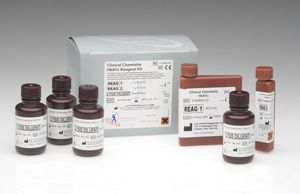
- Laboratory
- Laboratory medicine
- Sepsis test kit
- Axis-Shield PLC
Sepsis test kit FMHBP100IUOfor infectious diseasesapoptosisheparin binding protein
Add to favorites
Compare this product
Characteristics
- Applications
- sepsis, for infectious diseases
- Application field
- apoptosis
- Tested parameter
- heparin binding protein, fibrinogen
- Sample type
- cell, surface
- Analysis mode
- enzyme immunoassay
Description
Sepsis is the body’s systemic inflammatory response to infection and can progress to severe sepsis, septic shock and ultimately multiple organ failure and death. Early diagnosis and appropriate treatment of severe sepsis is vital to improve the patient’s chance of survival.
Heparin Binding Protein (HBP), also known as Cationic Antimicrobial Protein of 37kDa (CAP37) and azurocidin, is a 37kDa glycoprotein synthesised in neutrophils.
HBP is released from the secretory vesicles of activated neutrophils on contact with the endothelium. Once released, it induces a calcium-dependent rearrangement of the endothelial cell cytoskeleton, resulting in cell contraction and increased permeability of the endothelium. It is also internalised by the endothelial cells to protect them from apoptosis. HBP is also released from the secretory vesicles when M-protein/fibrinogen complexes, which are formed when M-proteins are released from bacterial cell surfaces, interact with ί2-integrins on the neutrophil cell surface. At the site of infection, HBP is also secreted from the azurophil granules during phagocytosis, where it exhibits antimicrobial activity and is responsible for the recruitment and activation of monocytes and other inflammatory mediators. It is also internalised by monocytes to prolong survival and enhance cytokine production.
HBP therefore directly contributes to the maintenance and progression of inflammation and it has been demonstrated in several major publications that measurement of HBP could be useful in identifying patients on admission to the Emergency Department who are at risk of developing sepsis with circulatory failure.
Catalogs
No catalogs are available for this product.
See all of Axis-Shield PLC ‘s catalogsRelated Searches
- Assay kit
- Blood assay kit
- Serum assay kit
- Immunoassay assay kit
- Plasma assay kit
- Infectious disease detection kit
- Blood rapid diagnostic test
- Serum rapid diagnostic test
- Plasma rapid diagnostic test
- Clinical assay kit
- ELISA assay kit
- IgG test kit
- Strip detection kit
- Bacteria rapid diagnostic test
- Laboratory detection kit
- Cell assay kit
- Antibody assay kit
- Clinical rapid diagnostic test
- Cardiovascular disease assay kit
- Biochemistry assay kit
*Prices are pre-tax. They exclude delivery charges and customs duties and do not include additional charges for installation or activation options. Prices are indicative only and may vary by country, with changes to the cost of raw materials and exchange rates.









